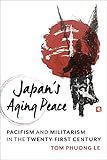Japan's Aging Peace : Pacifism and Militarism in the Twenty-First Century / Tom Phuong Le.
Material type: TextSeries: Contemporary Asia in the WorldPublisher: New York, NY : Columbia University Press, [2021]Copyright date: ©2021Description: 1 online resource : 31 b&w imagesContent type:
TextSeries: Contemporary Asia in the WorldPublisher: New York, NY : Columbia University Press, [2021]Copyright date: ©2021Description: 1 online resource : 31 b&w imagesContent type: - 9780231553285
- 303.6/60952 23
- UA845 .L42 2021
- online - DeGruyter
| Item type | Current library | Call number | URL | Status | Notes | Barcode | |
|---|---|---|---|---|---|---|---|
 eBook
eBook
|
Biblioteca "Angelicum" Pont. Univ. S.Tommaso d'Aquino Nuvola online | online - DeGruyter (Browse shelf(Opens below)) | Online access | Not for loan (Accesso limitato) | Accesso per gli utenti autorizzati / Access for authorized users | (dgr)9780231553285 |
Frontmatter -- Contents -- Figures and Tables -- Preface -- Note on Names and Currency -- 1 Japan’s Aging Peace -- 2 Multiple Militarisms -- 3 Who Will Fight? The JSDF’s Demographic Crises -- 4 Technical-Infrastructural Constraints and the Capacity Crises -- 5 Antimilitarism and the Politics of Restraint -- 6 Peace Culture and Normative Restraints -- 7 Crafting Peace Among Militarisms -- 8 Aging Gracefully -- Appendix A: Guidelines for Japan-U.S. Defense Cooperation (Abridged) -- Appendix B: Peace Museums and War History Museums in Japan -- Notes -- Bibliography -- Index -- CONTEMPORARY ASIA IN THE WORLD
restricted access online access with authorization star
http://purl.org/coar/access_right/c_16ec
Since the end of World War II, Japan has not sought to remilitarize, and its postwar constitution commits to renouncing aggressive warfare. Yet many inside and outside Japan have asked whether the country should or will return to commanding armed forces amid an increasingly challenging regional and global context and as domestic politics have shifted in favor of demonstrations of national strength.Tom Phuong Le offers a novel explanation of Japan’s reluctance to remilitarize that foregrounds the relationship between demographics and security. Japan’s Aging Peace demonstrates how changing perceptions of security across generations have culminated in a culture of antimilitarism that constrains the government’s efforts to pursue a more martial foreign policy. Le challenges a simple opposition between militarism and pacifism, arguing that Japanese security discourse should be understood in terms of “multiple militarisms,” which can legitimate choices such as the mobilization of the Japan Self-Defense Forces for peacekeeping operations and humanitarian relief missions. Le highlights how factors that are not typically linked to security policy, such as aging and declining populations and gender inequality, have played crucial roles. He contends that the case of Japan challenges the presumption in international relations scholarship that states must pursue the use of force or be punished, showing how widespread normative beliefs have restrained Japanese policy makers. Drawing on interviews with policy makers, military personnel, atomic bomb survivors, museum coordinators, grassroots activists, and other stakeholders, as well as analysis of peace museums and social movements, Japan’s Aging Peace provides new insights for scholars of Asian politics, international relations, and Japanese foreign policy.
Mode of access: Internet via World Wide Web.
In English.
Description based on online resource; title from PDF title page (publisher's Web site, viewed 01. Dez 2022)


